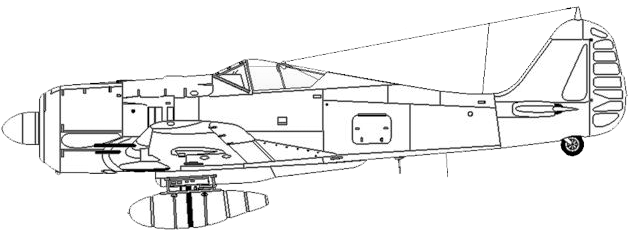Focke Wulf Fw 190
Operational History: The Sturmböcke
The appearance of United States Army Air Forces heavy bombers caused a problem for the German fighter force. The B-17 Flying Fortress in particular could absorb heavy punishment. The armament of the Bf 109 and then current Fw 190 were not adequate for bomber-destroyer operations, with the B-17's eventual deployment in the combat box formations providing their defensive armament with formidable massed firepower from a hundred or more Browning AN/M2 .50 caliber machine guns between all the bombers in such a formation, from almost any conceivable direction. In addition, the Luftwaffe's original solution of Zerstörer twin-engine Messerschmitt Bf 110G bomber destroyers, while effective against unescorted Allied bomber formations, lacked maneuverability and were eviscerated by the USAAF's fighter escorts in late 1943 and early 1944. Two of the former Wilde Sau single-engined night fighter wings were reconstituted for their use, such as Jagdgeschwader 300 (JG 300, or Fighter Wing 300) and JG 301. These units consisted of Sturmböcke. However, JG 3 also had a special gruppe (group) of Sturmböcke. The Fw 190, designed as a rugged interceptor capable of withstanding considerable combat damage and delivering a potent 'punch' from its stable gun platform, was considered ideal for anti-bomber operations. Focke-Wulf redesigned parts of the wing structure to accommodate larger armament. The Fw 190A-6 was the first sub-variant to undergo this change. Its standard armament was increased from four MG 151/20s to two of them with four more in two underwing cannon pods. The aircraft was designated A-6/R1 (Rüstsatz; or field conversion model). The first aircraft were delivered on 20 November 1943. Brief trials saw the twin cannon replaced by the MK 108 30mm autocannon in the outer wing, which then became the A-6/R2. The cannons were blowback-operated, had electric ignition, and were belt fed. The 30mm MK 108 was simple to make and its construction was economical; the majority of its components consisted of just pressed sheet metal stampings. In the A-6/R4, the GM-1 (nitrous oxide) Boost was added for the BMW 801 engine to increase performance at high altitude. For protection, 30 millimetres (1.2 in) of armoured glass was added to the canopy. The A-6/R6 was fitted with twin heavy calibre Werfer-Granate 21 (BR 21) unguided, air-to-air rockets, fired from single underwing tubular launchers (one per wing panel). The increased modifications, in particular heavy firepower, made the Fw 190 a potent bomber-killer. The A-7 evolved in November 1943. Two synchronized 13mm (.51 caliber) MG 131 machine guns replaced the twin cowl-mount synchronized 7.92mm (.318 cal) MG 17 machine guns. The A-7/R variants could carry two 30mm MK 108s as well as BR 21 rockets. This increased its potency as a Pulk-Zerstörer (Bomber Formation Destroyer). The A-8/R2 was the most numerous Sturmbock aircraft, some 900 were built by Fiesler at Kassel with 30mm MK 108s installed in their outer wing panel mounts.
Focke Wulf Fw 190A-6
"Advantages; wide undercarriage, large twin-row radial engine which protected the pilot from the front, electric starter motor and electric trim system. Disadvantages; there was a danger of turning over when braking hard on soft or sandy ground. In combat against enemy fighters, more awkward because of the heavy armour plating. Strong at low altitude, inferior to the Bf 109 at higher altitude. In my opinion the Fw 190, in this version, was the best aircraft used in the formation against the Viermots."Richard Franz commented:
"When we made our attack, we approached from slightly above, then dived, opening fire with 13mm and 20mm guns to knock out the rear gunner and then, at about 150 metres, we tried to engage with the MK 108 30mm cannon, which was a formidable weapon. It could cut the wing off a B-17. Actually, it was still easier to kill a B-24, which was somewhat weaker in respect of fuselage strength and armament. I think we generally had the better armament and ammunition, whereas they had the better aircraft."
Sources:
Gunston, Bill - The Encyclodepia of the Worlds Combat aircraft, 1976, Chartwell Books, Inc., New York
Brown, Eric, Captain - Wings of the Luftwaffe , 1979, Airlife Publishing Ltd., Shrewsbury
, 1979, Airlife Publishing Ltd., Shrewsbury
Gunston, Bill & Wood, Tony - Hitler's Luftwaffe , 1977, Salamander
Books Ltd., London
, 1977, Salamander
Books Ltd., London
Donald, David - The Complete Encyclopedia Of World Aircraft, 1997, Brown Packaging Books Ltd., London
Wikipedia - Fw 190
Gunston, Bill - The Encyclodepia of the Worlds Combat aircraft, 1976, Chartwell Books, Inc., New York
Brown, Eric, Captain - Wings of the Luftwaffe
Gunston, Bill & Wood, Tony - Hitler's Luftwaffe
Donald, David - The Complete Encyclopedia Of World Aircraft, 1997, Brown Packaging Books Ltd., London
Wikipedia - Fw 190






